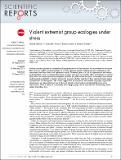| dc.contributor.author | Cebrian, Manuel | |
| dc.contributor.author | Torres, Manuel R. | |
| dc.contributor.author | Huerta, Ramon | |
| dc.contributor.author | Fowler, James H. | |
| dc.date.accessioned | 2014-07-08T19:53:06Z | |
| dc.date.available | 2014-07-08T19:53:06Z | |
| dc.date.issued | 2013-03 | |
| dc.date.submitted | 2012-08 | |
| dc.identifier.issn | 2045-2322 | |
| dc.identifier.uri | http://hdl.handle.net/1721.1/88214 | |
| dc.description.abstract | Violent extremist groups are currently making intensive use of Internet fora for recruitment to terrorism. These fora are under constant scrutiny by security agencies, private vigilante groups, and hackers, who sometimes shut them down with cybernetic attacks. However, there is a lack of experimental and formal understanding of the recruitment dynamics of online extremist fora and the effect of strategies to control them. Here, we utilize data on ten extremist fora that we collected for four years to develop a data-driven mathematical model that is the first attempt to measure whether (and how) these external attacks induce extremist fora to self-regulate. The results suggest that an increase in the number of groups targeted for attack causes an exponential increase in the cost of enforcement and an exponential decrease in its effectiveness. Thus, a policy to occasionally attack large groups can be very efficient for limiting violent output from these fora. | en_US |
| dc.description.sponsorship | National Science Foundation (U.S.) (Grant 0905645) | en_US |
| dc.description.sponsorship | United States. Defense Advanced Research Projects Agency (Lockheed Martin Guard Dog Program PO 4100149822) | en_US |
| dc.description.sponsorship | United States. Army Research Office (Grant W911NF-11-1-0363) | en_US |
| dc.language.iso | en_US | |
| dc.publisher | Nature Publishing Group | en_US |
| dc.relation.isversionof | http://dx.doi.org/10.1038/srep01544 | en_US |
| dc.rights | Creative Commons Attribution-NonCommercial-NoDerivs 3.0 | en_US |
| dc.rights.uri | http://creativecommons.org/licenses/by-nc-nd/3.0/ | en_US |
| dc.source | National Academy of Sciences (U.S.) | en_US |
| dc.title | Violent extremist group ecologies under stress | en_US |
| dc.type | Article | en_US |
| dc.identifier.citation | Cebrian, Manuel, Manuel R. Torres, Ramon Huerta, and James H. Fowler. “Violent Extremist Group Ecologies Under Stress.” Sci. Rep. 3 (March 27, 2013). | en_US |
| dc.contributor.department | Massachusetts Institute of Technology. Media Laboratory | en_US |
| dc.contributor.mitauthor | Cebrian, Manuel | en_US |
| dc.relation.journal | Scientific Reports | en_US |
| dc.eprint.version | Final published version | en_US |
| dc.type.uri | http://purl.org/eprint/type/JournalArticle | en_US |
| eprint.status | http://purl.org/eprint/status/PeerReviewed | en_US |
| dspace.orderedauthors | Cebrian, Manuel; Torres, Manuel R.; Huerta, Ramon; Fowler, James H. | en_US |
| mit.license | PUBLISHER_CC | en_US |
| mit.metadata.status | Complete | |
